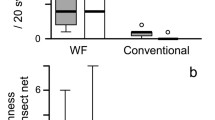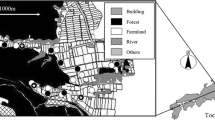Abstract
Earlier studies showed environmentally friendly farming (EFF) increased the populations of various organisms in agricultural landscapes, but the mechanisms of these increases were not well studied, due to a lack of knowledge on their temporal dynamics. Here, we examined spatio-temporal dynamics of Tetragnatha spiders, natural enemies of rice pests, in EFF and conventional farming (CF). Field surveys were conducted in 15 paddy fields under CF and 18 under EFF during three seasons in Tochigi Prefecture, central Japan. The results showed that Tetragnatha spiders were more abundant in paddy fields than in ditches during the growing season, but this tendency was reversed during the non-crop season. Thus, complementary utilization of ditches and paddy fields during different seasons appeared to maintain Tetragnatha populations. Both Tetragnatha spider and flying insect abundance increased in paddy fields under only EFF when the surrounding forest cover was high. There was a significant positive correlation between the density of flying insects and the population growth rate of Tetragnatha spiders, suggesting a bottom-up effect of flying insects emerging from paddy fields. We concluded that the high potential productivity in paddy fields, coupled with the presence of ditches as important habitats, maintained the high abundance of Tetragnatha spiders in paddy-dominated landscapes.







Similar content being viewed by others
References
Amano T, Kusumoto Y, Okamura H, Baba YG, Hamasaki K, Tanaka K, Yamamoto S (2011) A macro-scale perspective on within-farm management: how climate and topography alter the effect of farming practices. Ecol Lett 14:1263–1272
Blitzer EJ, Dormann CF, Holzschuh A, Klein AM, Rand TA, Tscharntke T (2012) Spillover of functionally important organisms between managed and natural habitats. Agric Ecosyst Environ 146:34–43
Cebrian J (1999) Patterns in the fate of production in plant communities. Am Nat 154:449–468
Diehl E, Mader VL, Wolters V, Birkhofer K (2013) Management intensity and vegetation complexity affect web-building spiders and their prey. Oecologia 173:579–589
Elphick CS (2000) Functional equivalency between rice fields and seminatural wetland habitats. Conserv Biol 14:181–191
Hayasaka D, Korenaga T, Sánchez-Bayo F, Goka K (2012a) Differences in ecological impacts of systemic insecticides with different physicochemical properties on biocenosis of experimental paddy fields. Ecotoxicology 21:191–201
Hayasaka D, Korenaga T, Suzuki K, Saito F, Sanchez-Bayo F, Goka K (2012b) Cumulative ecological impacts of two successive annual treatments of imidacloprid and fipronil on aquatic communities of paddy mesocosms. Ecotox Environ Safe 80:355–362
Hazell PBR (2010) The Asian green revolution. In: Spielman DJ, Pandya-Lorch R (eds) Proven successes in agricultural development: a technical compendium to Millions Fed. International Food Policy Research Institute, Washington, DC, pp 67–98
Katano O, Hosoya K, Iguchi K, Yamaguchi M, Aonuma Y, Kitano S (2003) Species diversity and abundance of freshwater fishes in irrigation ditches around rice fields. Environ Biol Fish 66:107–121
Katayama N, Baba YG, Kusumoto Y, Tanaka K (2015) A review of post-war changes in rice farming and biodiversity in Japan. Agric Syst 132:73–84
Katoh K, Sakai S, Takahashi T (2009) Factors maintaining species diversity in satoyama, a traditional agricultural landscape of Japan. Biol Conserv 1429:1930–1936
Kikuchi E, Takagi Y, Shikano S (2012) Surveys of plankton (aquatic microorganisms) communities in rice fields. Res Bull Environ Educ Cent Miyagi Univ Educ 14:7–15 (in Japanese with English summary)
Kiritani K (2000) Integrated biodiversity management in paddy fields: shift of paradigm from IPM toward IBM. Integr Pest Manage Rev 5:175–183
Kiritani K, Kawahara S, Sasaba T, Nakasuji F (1972) Quantitative evaluation of predation by spiders on the green rice leafhopper, Nephotettix cincticeps Uhler, by a sight-count method. Res Popul Ecol 13:187–200
Kobayashi T, Takada M, Takagi S, Yoshioka A, Washitani I (2011) Spider predation on a mirid pest in Japanese rice fields. Basic Appl Ecol 12:532–539
Kobori H, Primack RB (2003) Participatory conservation approaches for Satoyama, the traditional forest and agricultural landscape of Japan. AMBIO J Hum Env 32:307–311
Maclean JL, Dawe DC, Hardy B, Hettel GP (2002) Rice almanac: source book for the most important economic activity of earth. CABI, Wallingford, pp 59–236
McGarigal K, Cushman SA (2002) Comparative evaluation of experimental approaches to the study of habitat fragmentation effects. Ecol Appl 12:335–345
Miyashita T, Takada M, Shimazaki A (2003) Experimental evidence that aboveground predators are sustained by underground detritivores. Oikos 103:31–36
Miyashita T, Chishiki Y, Takagi RS (2012) Landscape heterogeneity at multiple spatial scales enhances spider species richness in an agricultural landscape. Popul Ecol 54:573–581
Miyashita T, Yamanaka M, Tsutsui HM (2014) Distribution and abundance of organisms in paddy-dominated landscapes with implication for wildlife-friendly farming. In: Miyashita T, Nishikawa U (eds) Social-ecological restoration in paddy-dominated landscapes. Springer, Japan, pp 45–65
Nakanishi K, Tawa K, Kanbara B, Noma N, Sawada H (2009) Comparisons of macro-aquatic animal communities among paddy fields under different cultivation management systems. Jpn J Environ Entomol Zool 20:103–114
Pimentel D, Stachow U, Takacs DA, Brubaker HW, Dumas AR, Meaney JJ, Oneil JAS, Onsi DE, Corzilius DB (1992) Conserving biological diversity in agricultural/forestry systems. Bioscience 42:354–362
Polis GA, Hurd SD, Jackson CT, Sanchez-Piñero F (1998) Multifactor population limitation: variable spatial and temporal control of spiders on Gulf of California islands. Ecology 79:490–502
R Development Core Team (2013) R: a language and environment for statistical computing. R Foundation for Statistical Computing, Vienna, Austria. ISBN 3-900051-07-0, https://cran.r-project.org/bin/windows/base/old/3.0.1/. Accessed 5 Nov 2013
Rand TA, Tylianakis JM, Tscharntke T (2006) Spillover edge effects: the dispersal of agriculturally subsidized insect natural enemies into adjacent natural habitats. Ecol Lett 9:603–614
Schmidt MH, Thies C, Nentwig W, Tscharntke T (2008) Contrasting responses of arable spiders to the landscape matrix at different spatial scales. J Biogeogr 35:157–166
Takada MB, Yoshioka A, Takagi S, Iwabuchi S, Washitani I (2012) Multiple spatial scale factors affecting mirid bug abundance and damage level in organic rice paddies. Biol Control 60:169–174
Takada MB, Takagi S, Iwabuchi S, Mineta T, Washitani I (2014) Comparison of generalist predators in winter-flooded and conventionally managed rice paddies and identification of their limiting factors. SpringerPlus 3:418
Takamura K, Yasuno M (1986) Effects of pesticide application on chironomid larvae and ostracods in rice fields. Appl Entomol Zool 21:370–376
Tanaka K, Ihara H (2012) Biodiversity research for the development of indicator organisms in environment-preserving agriculture. In: Nakano S, Yahara T, Nakashizuka T (eds) The biodiversity observation networks in the Asia-Pasific Region. Springer, Japan, pp 95–113
Tanaka K, Ihara H (2013) Outline of the research project on biodiversity and the manual of indicator animals. JATAFF J 1:2–8 (in Japanese with English summary)
Tscharntke T, Tylianakis JM, Rand TA, Didham RK, Fahrig L, Batáry P, Bengtsson J, Clough Y, Crist TO, Dormann CF et al (2012) Landscape moderation of biodiversity patterns and processes—eight hypotheses. Biol Rev 87:661–685
Ushio N, Saito R, Akanuma H, Watanabe R (2014) Effectiveness of wildlife-friendly farming on aquatic macroinvertebrate diversity on Sado Island in Japan. In: Miyashita T, Nishikawa U (eds) Social-ecological restoration in paddy-dominated landscapes. Springer, Japan, pp 95–113
Yoshida M (1981) Preliminary study on the ecology of three horizontal orb weavers, Tetragnatha praedonia, T. japonica, and T. pinicola (Araneae: Tetragnathidae). Acta Arachnol 30:49–64
Yoshida M (1987) Predatory behavior of Tetragnatha praedonia (Araneae: Tetragnathidae). Acta Arachnol 35:57–75
Acknowledgments
We thank S. Sugiyama and all the farmers who permitted us to conducted surveys in their paddy fields, and we also thank G. Fujita, S. Naoe, S, Nishijima and other members of the Laboratory of Biodiversity Science for their help with the fieldwork and helpful suggestions. We would like to thank T. Kagaya for long-term support of our fieldwork, A. Tanikawa for advice on spider identification and Y. Osada for valuable advice on statistical analysis. This study was supported by the Global COE programme (the Center of Excellence for Asian Conservation Ecology) and JSPS KAKENHI (Grant No. 25292210, 15K14600).
Author information
Authors and Affiliations
Corresponding author
Rights and permissions
About this article
Cite this article
Tsutsui, M.H., Tanaka, K., Baba, Y.G. et al. Spatio-temporal dynamics of generalist predators (Tetragnatha spider) in environmentally friendly paddy fields. Appl Entomol Zool 51, 631–640 (2016). https://doi.org/10.1007/s13355-016-0440-5
Received:
Accepted:
Published:
Issue Date:
DOI: https://doi.org/10.1007/s13355-016-0440-5




